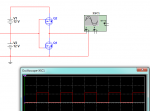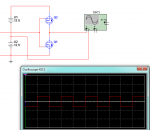You're trying to make the case that pulsed DC isn't AC? Does the current not alternate? Do not all components in the circuit behave as if they are in an AC circuit? A square wave is still a wave, and waves are generally known to alternate.
Are you just varying your voltage from 0 to V volts? That's not AC, and a resistive load (like a lamp) will just brighten and then dim as a function of voltage, not brighten-dim-brighten as a function of the half-cycle voltage level, i.e. brighten in the "positive" cycle, dim, and then brighten again in the "negative" cycle. If you put a
capacitor in series, yes, that would be AC (assuming your return is at 0 potential); however, the DC current cannot flow through a capacitor right? It would need to move back and forth to transfer power to the load.
Anyway, I don't understand what point you're trying to make here and the relationship to switches. Do you pulse your DC through a capacitor with your mechanical switch in order to mimic AC? 60 times a second? Most DC switches are responsible for
step-function type transients, not something resembling AC.
If you are switching something at fast rates, switches are already designed to account for that. For example, if you're using PWM to control a motor using an H-bridge, the transistors (which are switches, albeit not mechanical) have anti-parallel diodes to prevent the back-EMF from killing things. Likewise, class-D amplifiers have diodes to prevent the large transients from affecting electronics. The effects of high DC currents and transients are real and must be accounted for in your switches.
Mechanical switching isn't done before the filter caps of DC supplies - it's done on the AC side. Besides, both a 1pF cap and a 1F cap are "capacitive loads." There is no set number you can use for this.
For some AC-DC supplies, yes, but you really can't make such blanket statements for all circuit topologies. For example, step-up DC-DC converters have reservoir capacitors at the input in order to reduce burst loads from the batteries or other DC power sources. If you have a switch in between you're switching for a capacitive load designed for high-peak currents.
In the end, if your circuit doesn't have a capacitive load, then you don't need to factor that into your switch ratings.
The cap charging in an RC circuit happens at a very low current - negligible when it comes to switches.
Again, depends on the circuit. You're stating generalities which are not qualified. Think about something such as charging a super-capacitor. Some don't even need resistors because they can handle such large surges; can your switch?
I was looking around, and the
national electric code seems to think the current rating provides for incandescent lamps. I really don't think anyone in their right mind would derate a switch 80% for a light. Your typical wall switch is 10A, which means your lighting load would be limited to 240W (chandeliers are now off-limits?).
I assume you're using AC to power that chandelier? In that case the amp rating can be directly used for your lamp load--for AC. So 10A * 120V = 1200W. That sounds do-able.
Now if you're using, for some reason, a DC-powered chandelier, well then you will need to find a different switch, but good luck supplying 1200W of DC power anyway.







